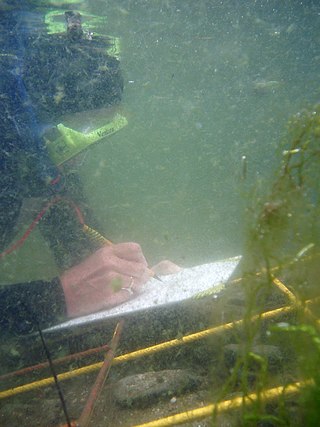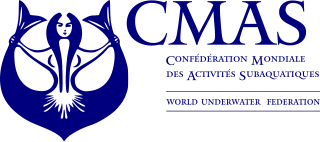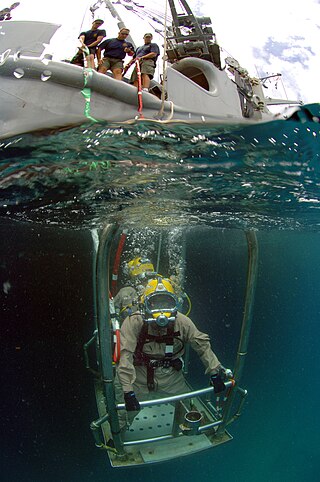Related Research Articles

Diving activities are the things people do while diving underwater. People may dive for various reasons, both personal and professional. While a newly qualified recreational diver may dive purely for the experience of diving, most divers have some additional reason for being underwater. Recreational diving is purely for enjoyment and has several specialisations and technical disciplines to provide more scope for varied activities for which specialist training can be offered, such as cave diving, wreck diving, ice diving and deep diving. Several underwater sports are available for exercise and competition.

Recreational diving or sport diving is diving for the purpose of leisure and enjoyment, usually when using scuba equipment. The term "recreational diving" may also be used in contradistinction to "technical diving", a more demanding aspect of recreational diving which requires more training and experience to develop the competence to reliably manage more complex equipment in the more hazardous conditions associated with the disciplines. Breath-hold diving for recreation also fits into the broader scope of the term, but this article covers the commonly used meaning of scuba diving for recreational purposes, where the diver is not constrained from making a direct near-vertical ascent to the surface at any point during the dive, and risk is considered low.

Professional diving is underwater diving where the divers are paid for their work. Occupational diving has a similar meaning and applications. The procedures are often regulated by legislation and codes of practice as it is an inherently hazardous occupation and the diver works as a member of a team. Due to the dangerous nature of some professional diving operations, specialized equipment such as an on-site hyperbaric chamber and diver-to-surface communication system is often required by law, and the mode of diving for some applications may be regulated.
The American Academy of Underwater Sciences (AAUS) is a group of scientific organizations and individual members who conduct scientific and educational activities underwater. It was organized in 1977 and incorporated in the State of California in 1983.

Scientific diving is the use of underwater diving techniques by scientists to perform work underwater in the direct pursuit of scientific knowledge. The legal definition of scientific diving varies by jurisdiction. Scientific divers are normally qualified scientists first and divers second, who use diving equipment and techniques as their way to get to the location of their fieldwork. The direct observation and manipulation of marine habitats afforded to scuba-equipped scientists have transformed the marine sciences generally, and marine biology and marine chemistry in particular. Underwater archeology and geology are other examples of sciences pursued underwater. Some scientific diving is carried out by universities in support of undergraduate or postgraduate research programs, and government bodies such as the United States Environmental Protection Agency and the UK Environment Agency carry out scientific diving to recover samples of water, marine organisms and sea, lake or riverbed material to examine for signs of pollution.

Public safety diving is underwater diving conducted as part of law enforcement and fire/rescue. Public safety divers differ from recreational, scientific and commercial divers who can generally plan the date, time, and location of a dive, and dive only if the conditions are conducive to the task. Public safety divers respond to emergencies 24 hours a day, 7 days a week, and may be required to dive in the middle of the night, during inclement weather, in zero visibility "black water," or in waters polluted by chemicals and biohazards.

Confédération Mondiale des Activités Subaquatiques (CMAS) is an international federation that represents underwater activities in underwater sport and underwater sciences, and oversees an international system of recreational snorkel and scuba diver training and recognition. It is also known by its English name, the World Underwater Federation, and its Spanish name, Confederación Mundial De Actividades Subacuáticas. Its foundation in Monaco during January 1959 makes it one of the world's oldest underwater diving organisations.

The diving supervisor is the professional diving team member who is directly responsible for the diving operation's safety and the management of any incidents or accidents that may occur during the operation; the supervisor is required to be available at the control point of the diving operation for the diving operation's duration, and to manage the planned dive and any contingencies that may occur. Details of competence, requirements, qualifications, registration and formal appointment differ depending on jurisdiction and relevant codes of practice. Diving supervisors are used in commercial diving, military diving, public safety diving and scientific diving operations.

Diver training is the set of processes through which a person learns the necessary and desirable skills to safely dive underwater within the scope of the diver training standard relevant to the specific training programme. Most diver training follows procedures and schedules laid down in the associated training standard, in a formal training programme, and includes relevant foundational knowledge of the underlying theory, including some basic physics, physiology and environmental information, practical skills training in the selection and safe use of the associated equipment in the specified underwater environment, and assessment of the required skills and knowledge deemed necessary by the certification agency to allow the newly certified diver to dive within the specified range of conditions at an acceptable level of risk. Recognition of prior learning is allowed in some training standards.

A diving instructor is a person who trains, and usually also assesses competence, of underwater divers. This includes freedivers, recreational divers including the subcategory technical divers, and professional divers which includes military, commercial, public safety and scientific divers.
The Underwater Society of America (USOA) is the peak body for underwater sport and recreational diving in the United States.
Diving safety is the aspect of underwater diving operations and activities concerned with the safety of the participants. The safety of underwater diving depends on four factors: the environment, the equipment, behaviour of the individual diver and performance of the dive team. The underwater environment can impose severe physical and psychological stress on a diver, and is mostly beyond the diver's control. Equipment is used to operate underwater for anything beyond very short periods, and the reliable function of some of the equipment is critical to even short-term survival. Other equipment allows the diver to operate in relative comfort and efficiency, or to remain healthy over the longer term. The performance of the individual diver depends on learned skills, many of which are not intuitive, and the performance of the team depends on competence, communication, attention and common goals.

The history of scuba diving is closely linked with the history of the equipment. By the turn of the twentieth century, two basic architectures for underwater breathing apparatus had been pioneered; open-circuit surface supplied equipment where the diver's exhaled gas is vented directly into the water, and closed-circuit breathing apparatus where the diver's carbon dioxide is filtered from the exhaled breathing gas, which is then recirculated, and more gas added to replenish the oxygen content. Closed circuit equipment was more easily adapted to scuba in the absence of reliable, portable, and economical high pressure gas storage vessels. By the mid-twentieth century, high pressure cylinders were available and two systems for scuba had emerged: open-circuit scuba where the diver's exhaled breath is vented directly into the water, and closed-circuit scuba where the carbon dioxide is removed from the diver's exhaled breath which has oxygen added and is recirculated. Oxygen rebreathers are severely depth limited due to oxygen toxicity risk, which increases with depth, and the available systems for mixed gas rebreathers were fairly bulky and designed for use with diving helmets. The first commercially practical scuba rebreather was designed and built by the diving engineer Henry Fleuss in 1878, while working for Siebe Gorman in London. His self contained breathing apparatus consisted of a rubber mask connected to a breathing bag, with an estimated 50–60% oxygen supplied from a copper tank and carbon dioxide scrubbed by passing it through a bundle of rope yarn soaked in a solution of caustic potash. During the 1930s and all through World War II, the British, Italians and Germans developed and extensively used oxygen rebreathers to equip the first frogmen. In the U.S. Major Christian J. Lambertsen invented a free-swimming oxygen rebreather. In 1952 he patented a modification of his apparatus, this time named SCUBA, an acronym for "self-contained underwater breathing apparatus," which became the generic English word for autonomous breathing equipment for diving, and later for the activity using the equipment. After World War II, military frogmen continued to use rebreathers since they do not make bubbles which would give away the presence of the divers. The high percentage of oxygen used by these early rebreather systems limited the depth at which they could be used due to the risk of convulsions caused by acute oxygen toxicity.

The following outline is provided as an overview of and topical guide to underwater diving:

Media diving is underwater diving in support of the media industries, including the practice of underwater photography and underwater cinematography outside of normal recreational interests. Media diving is often carried out in support of television documentaries, such as the BBC series Planet Earth or movies, with feature films such as Titanic and The Perfect Storm featuring underwater photography or footage. Media divers are normally highly skilled camera operators who use diving as a method to reach their workplace, although some underwater photographers start as recreational divers and move on to make a living from their hobby.
A code of practice can be a document that complements occupational health and safety laws and regulations to provide detailed practical guidance on how to comply with legal obligations, and should be followed unless another solution with the same or better health and safety standard is in place, or may be a document for the same purpose published by a self-regulating body to be followed by member organisations.

A diving team is a group of people who work together to conduct a diving operation. A characteristic of professional diving is the specification for minimum personnel for the diving support team. This typically specifies the minimum number of support team members and their appointed responsibilities in the team based on the circumstances and mode of diving, and the minimum qualifications for specified members of the diving support team. The minimum team requirements may be specified by regulation or code of practice. Some specific appointments within a professional dive team have defined competences and registration may be required.
A diver training standard is a document issued by a certification, registration, regulation, or quality assurance agency, that describes the prerequisites for participation, the aim of the training programme, the specific minimum competences that a candidate must display to be assessed as competent, and the minimum required experience that must be recorded before the candidate can be registered or certified at a specific grade by the agency. A standard is a description of the quality required of a product, or a way of doing something that has usually been derived from the experience of experts in a specific field. The purpose is to provide a reliable method for people to share a reasonably consistent expectation regarding the scope and quality of the product or service. Training standards allow objective comparison between the training provided by various agencies and the competence indicated by certification or registration to the specific standard, though in most cases, training and competence may exceed the minimum requirement much of the time, and variation between newly certified divers can be considerable, partly due to differences in the training, and partly due to qualities of the candidate. Training standards may narrowly prescribe the training, or may concentrate on assessment of exit level competence, and allow recognition of prior learning based on various forms of evidence. To be useful, a training standard must be sufficiently specific to allow agreement on the requirements by most readers reasonably competent in the field, including the instructors, assessors, and learners who must use it, the employers of persons trained, the potential customers, and any quality assurance personnel who may need to enforce it. A training standard may be linked to a code of practice referring to how the training should be carried out.
References
- 1 2 3 Occupational Health and Safety Act 85 of 1993 (PDF). Pretoria: Government Printer. 1993. Archived from the original (PDF) on 2018-09-21. Retrieved 2018-11-10– via www.labour.gov.za.
- 1 2 Staff (1977). "The Diving at Work Regulations 1997". Statutory Instruments 1997 No. 2776 Health and Safety. Kew, Richmond, Surrey: Her Majesty's Stationery Office (HMSO). Retrieved 6 November 2016.
- 1 2 "Subpart: T - Commercial Diving Operations. Standard Number: 1910.424 - SCUBA diving". Regulations (Standards - 29 CFR), Part Number: 1910, Occupational Safety and Health Standards. Washington, DC: US Department of Labour, Occupational Safety and Health Administration. Retrieved 16 November 2016.
- 1 2 3 4 5 "Diving Regulations 2009". Occupational Health and Safety Act 85 of 1993 – Regulations and Notices – Government Notice R41. Pretoria: Government Printer. Archived from the original on 2016-11-04. Retrieved 3 November 2016– via Southern African Legal Information Institute.
- ↑ Staff (February 2014). "IMCA International Code of Practice for Offshore Diving" (PDF). IMCA D 014 Rev. 2. London: International Marine Contractor's Association. Retrieved 22 July 2016.
- ↑ AAUS. "The AAUS Standards for Scientific Diving Certification and Operation of Scientific Diving Programs". Archived from the original on 2008-05-18. Retrieved 2008-07-13.
- ↑ AAUS. "A brief history of the AAUS exemption". Archived from the original on 2008-05-18. Retrieved 2008-07-13.
- ↑ Sharkey, P.; Austin, L. (1983). "Federal Regulation Of Scientific Diving: Two Scientific Divers' Perspective". Proceedings OCEANS '83. pp. 460–463. doi:10.1109/OCEANS.1983.1152066. S2CID 23322218.
- ↑ Flemming, N. C.; Max, M. D., eds. (1988), Code of Practice for Scientific Diving: Principles for the Safe Practice of Scientific Diving in Different Environments. UNESCO Technical Papers in Marine Science 53 (PDF), Scientific Committee of Confédération Mondiale des Activités Subaquatiques, Paris, France: United Nations Educational, Scientific, and Cultural Organization, Div. of Marine Sciences, ISSN 0503-4299, OCLC 18056894 , retrieved 8 February 2013
- ↑ "Recreational diving Act, 1979" (in Hebrew). Knesset. 1979. Retrieved 16 November 2016– via WikiSource.
- ↑ Staff (16 December 2015). "Consolidated decree on the entry into force for Greenland of the act on diving operations and diving equipment, etc" (PDF). Act on diving operations and diving equipment, etc. Copenhagen, Denmark: Danish Maritime Authority (Søfartsstyrelsen). Retrieved 16 November 2016.
- ↑ "Regulation of professional diving". www.argentina.gob.ar. Argentine Naval Prefecture. Retrieved 23 March 2021.
- ↑ "Complementary rules to the regulation of sports diving activities (decree no. 166-2001 chapter 12 of title 4 of the reginave)". www.argentina.gob.ar. Argentine Naval Prefecture. Retrieved 23 March 2021.
- ↑ Staff (2 December 2011). "Recreational Diving, Recreational Technical Diving and Snorkelling Code of Practice 2011" (PDF). Queensland Government Gazette. Brisbane, Queensland: Minister for Education and Industrial Relations. Archived from the original (PDF) on 21 January 2017. Retrieved 16 November 2016.
- ↑ "Verordnung über die Sicherheit der Arbeitnehmerinnen und Arbeitnehmer bei Arbeiten im Überdruck". fedlex.ch (in German). Retrieved 2 September 2021.
- ↑ "Ordonnance sur la sécurité des travailleurs lors de travaux en milieu hyperbare". fedlex.ch (in French). Retrieved 2 September 2021.
- ↑ "Ordinanza sulla sicurezza dei lavoratori nei lavori in condizioni di sovrappressione". fedlex.ch (in Italian). Retrieved 2 September 2021.